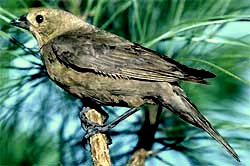With Song Sparrows,
Sometimes Things Go Wrong
If a typical pair of Song Sparrows produces three broods a year of five eggs each, that means that, if everything goes well, at year's end instead of two birds there will be seventeen. If all seventeen, half males and half females, repeat the process the next year, there will be, instead of seventeen, statistically speaking, 144.5 birds. If no bird dies and the entire process is repeated yet a third year, there will 1,228.25 birds. Clearly, something has to give.
What "gives" is that a high percentage of young birds die before reaching mating age. House cats, snakes, skunks, hawks, and other predators eat them; storms blow their nests down, floods drown them... If they make it to the end of their first summer, then they have migration to deal with, flying hundreds of miles south into an unfamiliar land, with unfamiliar kinds of food, and often it can get awfully cold, even in the species' wintering grounds.
 One of the Song Sparrow's greatest enemies is not a snake or a storm, however, but rather another bird: The Brown-headed Cowbird, a female of which is shown at the right (only the males have brown heads). Brown-headed Cowbirds are nest parasites. In other words, when the female Brown-headed Cowbird feels that she is ready to lay an egg, she seeks out the nest of another bird species, lays the egg, and lets the other parents raise her young!
One of the Song Sparrow's greatest enemies is not a snake or a storm, however, but rather another bird: The Brown-headed Cowbird, a female of which is shown at the right (only the males have brown heads). Brown-headed Cowbirds are nest parasites. In other words, when the female Brown-headed Cowbird feels that she is ready to lay an egg, she seeks out the nest of another bird species, lays the egg, and lets the other parents raise her young!
Brown-headed Cowbird nest-parasitism is not a rare and insignificant event. In one study in Ohio, between 24.6 and 77.7 percent of all Song Sparrow nests contained Brown-headed Cowbird eggs or young. The average nest size of 66 non-parasitized nests was 3.4 nestlings, while the average size of 28 parasitized nests was 2.4 Song Sparrow nestlings, plus the young Brown-headed Cowbird. Thus, each Brown-headed Cowbird nestling was raised at the expense of exactly one Song Sparrow.
As many as seven Brown-headed Cowbird eggs have been found in a single Song Sparrow nest. Rarely, Song Sparrows recognize that something is wrong, and build a new nest atop the old one, covering the Brown-headed Cowbird egg so that it never hatches.
Earlier we said that mankind's destruction of the natural environment had benefited the Song Sparrow by producing so many weedy areas, which Song Sparrows like. With regard to the heavy damage suffered by Song Sparrows because of Brown-headed Cowbird parasitization, mankind's destruction of the great forests has hurt the Song Sparrow, and all the other many species the Brown-headed Cowbird parasitizes.
That's because Brown-headed Cowbirds avoid forest interiors, and enter them only along the edges. Therefore, when vast forests covered much of the continent, Brown-headed Cowbirds had relatively fewer places to go. Now that the forests are broken up into many small parcels, few forests are very deep, and the Brown-headed Cowbird has an abundance of forest edges to visit. Brown-headed Cowbird numbers have skyrocketed.
Sometimes Song Sparrow parents raise young Brown-headed Cowbirds with their own young. Other times, Brown-headed Cowbirds actually remove Song Sparrow eggs from Song Sparrow nests, to make room for their own. And sometimes the larger Brown-headed Cowbird nestlings crush their Song Sparrow nest-mates, or are so aggressive in begging for food that one or more Song Sparrow nestlings starve.
Despite such dangers, obviously, the Song Sparrow species survives, and even flourishes. Moreover, when we see that the species "has the spirit" to chase five House Sparrows from a feeder, the vitality to engender over 1,200 descendants in just three years, and an appetite for the weediness mankind produces, it seems a good guess that Song Sparrows have a better chance of surviving the present ongoing mass extinction of species than most.
Return to Life Cycle Index Page
 One of the Song Sparrow's greatest enemies is not a snake or a storm, however, but rather another bird: The Brown-headed Cowbird, a female of which is shown at the right (only the males have brown heads). Brown-headed Cowbirds are nest parasites. In other words, when the female Brown-headed Cowbird feels that she is ready to lay an egg, she seeks out the nest of another bird species, lays the egg, and lets the other parents raise her young!
One of the Song Sparrow's greatest enemies is not a snake or a storm, however, but rather another bird: The Brown-headed Cowbird, a female of which is shown at the right (only the males have brown heads). Brown-headed Cowbirds are nest parasites. In other words, when the female Brown-headed Cowbird feels that she is ready to lay an egg, she seeks out the nest of another bird species, lays the egg, and lets the other parents raise her young!